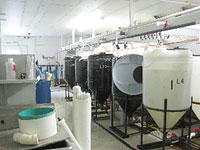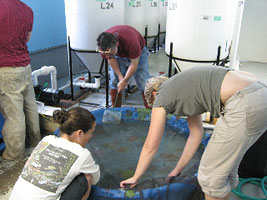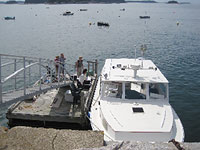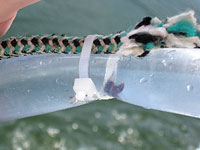

 | |||||||||||||||||||||||||||||||||||
|
|
Journals 2009/2010Jennifer Emblidge
August 12, 2009 Today I awoke at 4:30 a.m. in order to travel to the Penobscot Bay hatchery in Stonington, ME by 8 a.m.. The morning came really fast but it was a beautiful drive out to the hatchery. We got to see the sun rise and watch the fog lift off of the water. The director, a gentleman named Ted Ames, greeted us at the door to the hatchery. He introduced us to the two college interns, Alice and Leah, that he has working at the hatchery this summer and then we were given a quick tour of the hatchery. The hatchery contains one large wet room where most of the lobsters are held in large bins. The line-up begins with large trash bins containing female lobsters. The females, who were internally fertilized, hold their fertilized eggs on their abdomen while they develop for about 4-5 months. After this point, the stage one larvae will hatch from the eggs and they are released into the water column in the trash bin. Next, the larvae are scooped up and placed into the next row of containers. As the lobster larvae grow and develop from one stage to the next they are transferred to the next row of containers and until they reach the last row when they have reached a stage 5. The lobsters are constantly monitored and fed fresh brine shrimp by the hatchery employees. When the lobsters are at stage 5 they are moved into the neighboring room.
We were led into the room containing the stage 5 lobsters and put right to work! First, we had to empty the stage 5 lobsters from the containers they were being held in. These containers were big vats that contained PVC piping and netting for the lobsters to use to settle and hide within. We took the nets out of the vats and dumped them into a big pool. Then, we took out the netting and piping while making sure that the lobsters were not hiding in them. This cleared our way in the pool so we were able to net-up the lobsters and place them onto a tray. Then, Charlene, Rick and I went to work counting, weighing and measuring the lobsters. Once this was complete, we placed the lobsters into a cooler to be transported with us to the release sites. This year we had around 1,000 lobsters in our coolers. Originally, 6,000 stage 5 lobsters were placed into the vats. This means that the hatchery saw a very low survival rate this year for some reason.
This gives me the opportunity to introduce the Zone C Lobster Hatchery Project to you. The lobster fisheries on the coast of Maine have been divided spatially into 5 zones. Each zone has some freedom to individually regulate and control their own fishery. The Zone C fishery surrounds the Penobscot Bay area where the hatchery is located. The hatchery project is funded by Maine Sea Grant and also supervised by the Penobscot East Resource Center (PERC). It has been running for three years now. The hatchery was started because the lobster fishery in the Bay has been depleted. By hatching baby lobsters and releasing them into the bay, the Zone C fisherman hope to replenish their lobster fishery. The Wahle team is working with the hatchery in order to monitor its success. They have four sites in the bay that they are responsible for monitoring. Two of these areas (Oaks Island Point and Great Spruce Head West) are used as release sites and the other two (Mullen Head and Great Spruce Head East) are control sites. Once we had the coolers packed with lobsters, we transported them down to Pete Buxton's boat. He, like many other locals, has volunteered his time and boat to help out the area fisherman and scientists with this project. The tasks of the lobster deployment were as follows:
We also deployed a CTD at each of the four sites in order to get a better picture of the ocean geography, or the water column structure, at each location. The CTD unit is dropped from the boat into the water and it sinks to the ocean bottom. It records the conductivity, temperature and depth every half second as it is lowered. After we returned to the dock, I decided to go to the Lobster Co-op that was next to the hatchery and buy myself my first Maine lobster. I was able to walk right down to the docks and pick my own out. It was so exciting! I brought it back to the dorms and cooked myself up a yummy dinner! We will be returning next week to the four hatchery release sites in order to monitor how the release is progressing.
|
||||||||||||||||||||||||||||||||||









